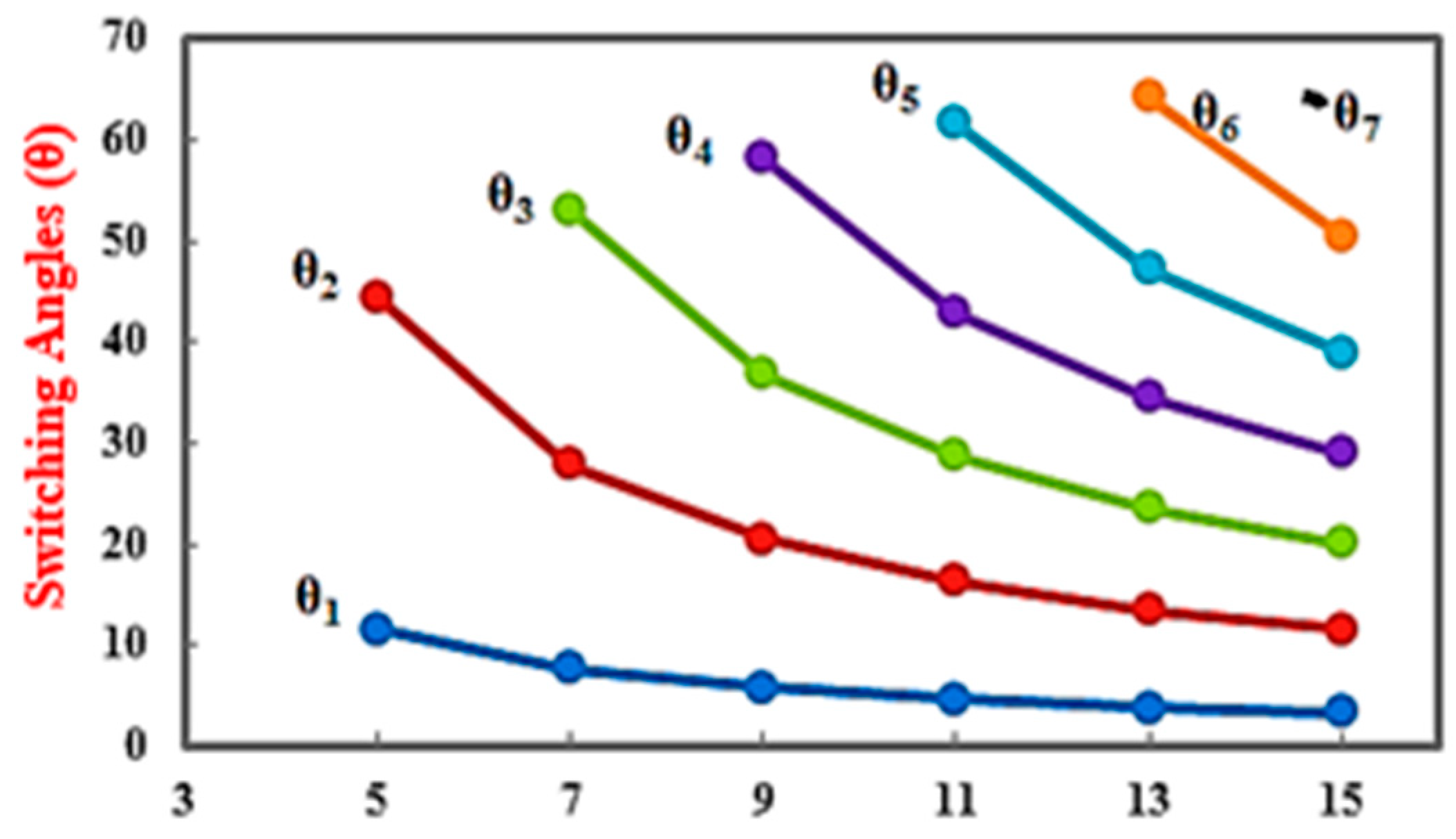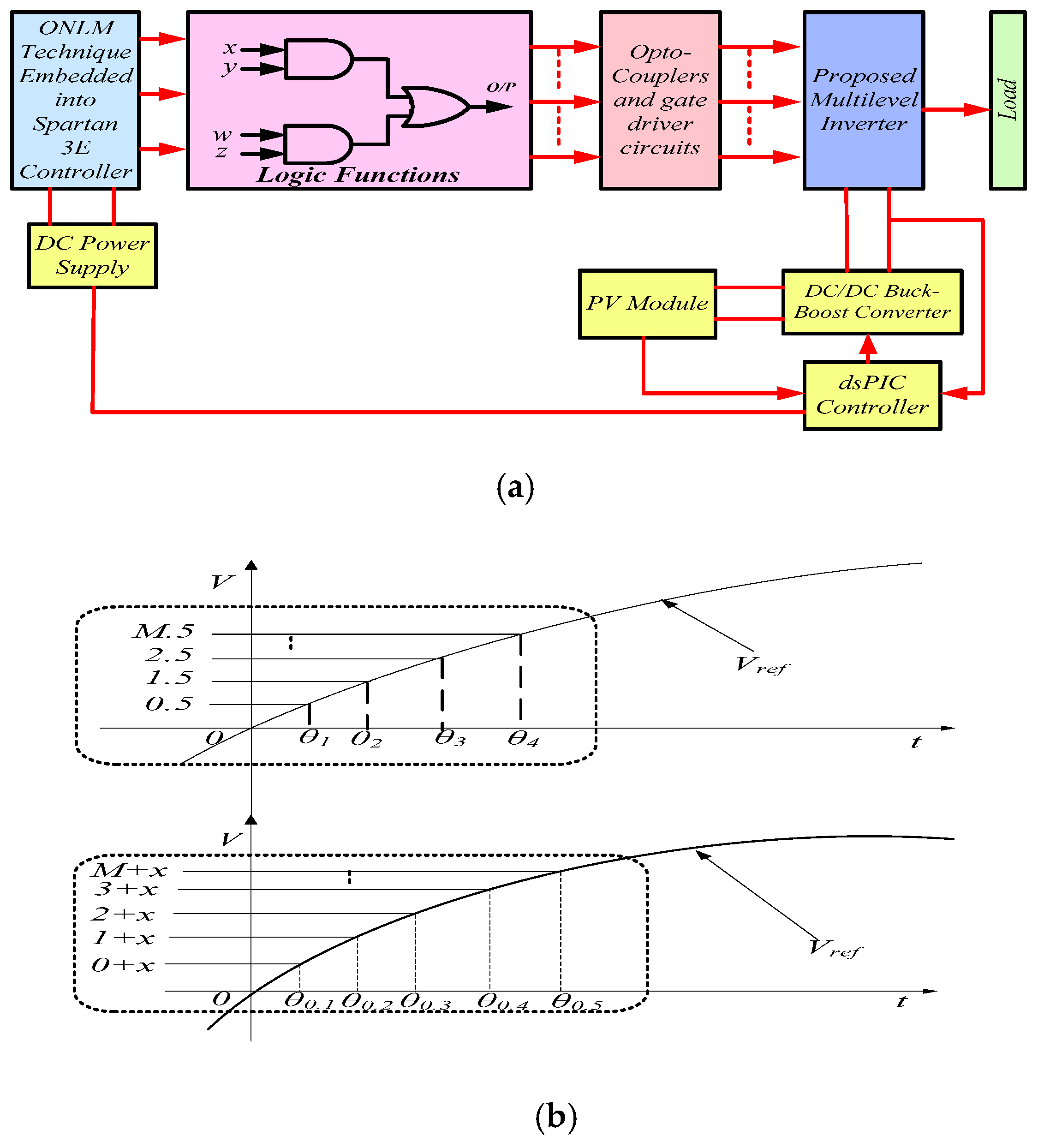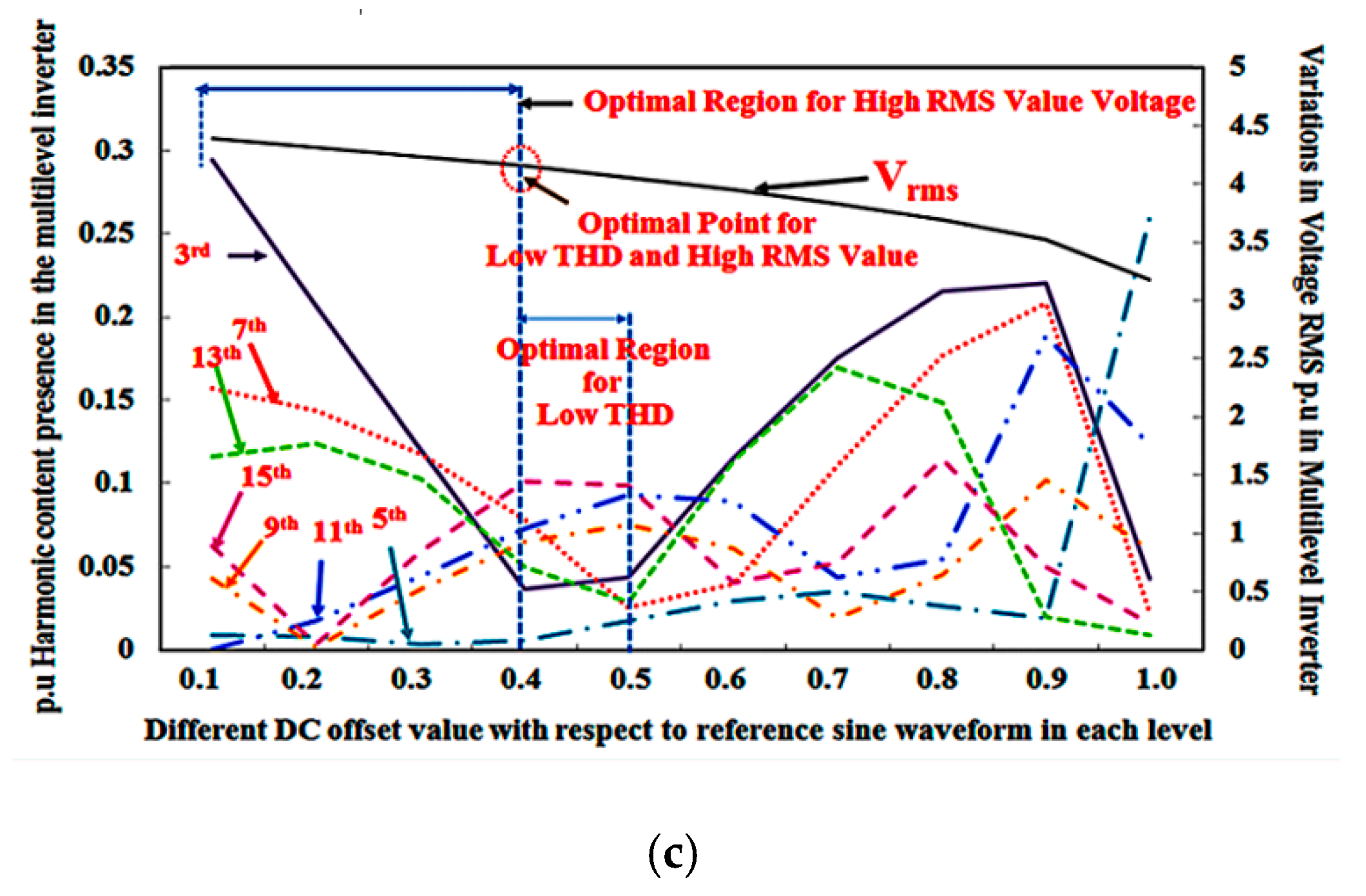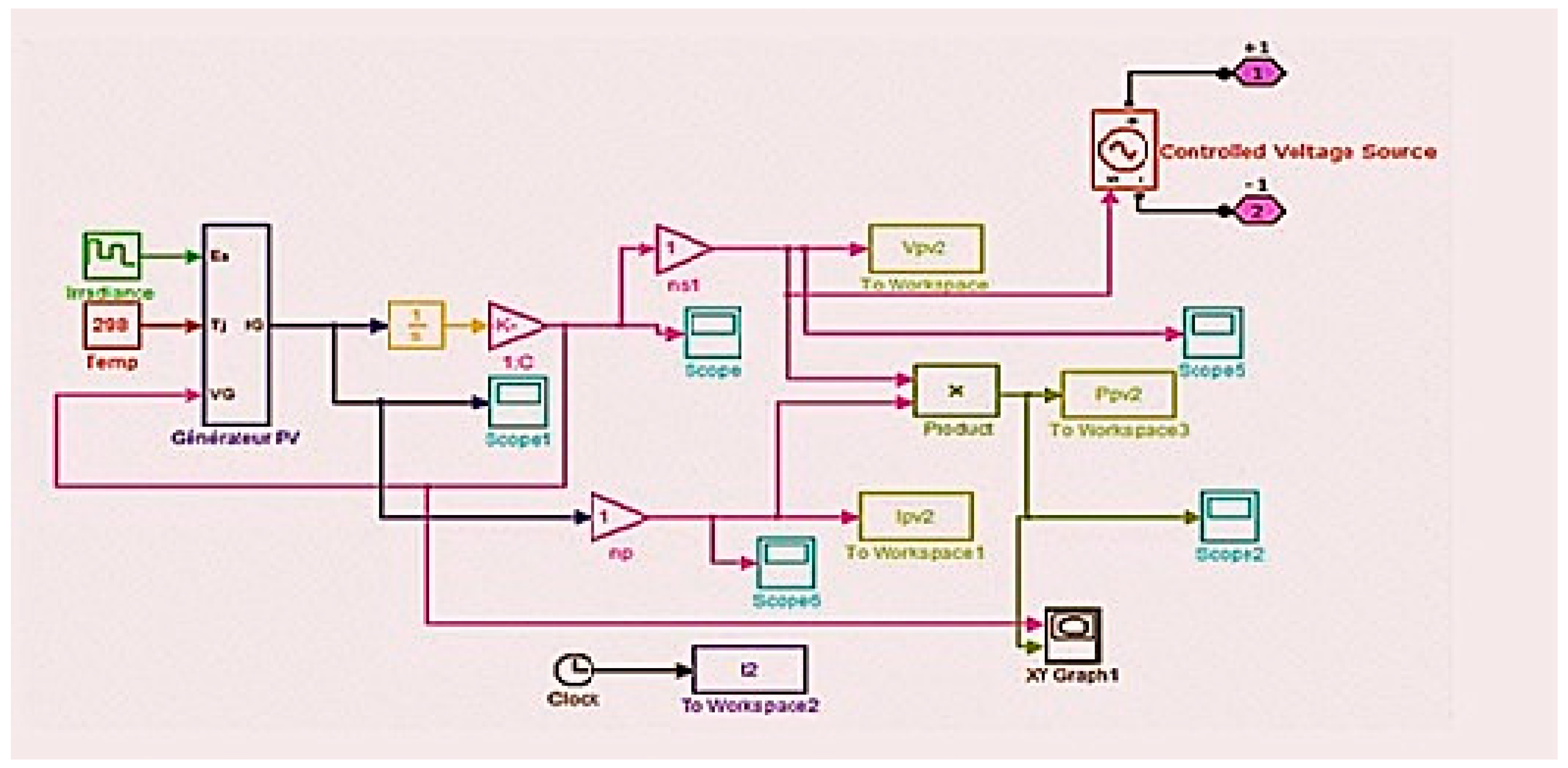Generalized Cascaded Symmetric and Level Doubling Multilevel Converter Topology with Reduced THD for Photovoltaic Applications
Abstract
:1. Introduction
2. Proposed Multilevel Converter
2.1. Proposed Basic Unit
2.2. Proposed Cascaded Topologies
3. Modified DC-Offset Value in the NLM Method
4. Simulation and Experimental Results
- Vpp = 3 × 110 = 330 V, Vrms = Vpp/sqrt (2)
- Vrms = 330/sqrt (2) = 232.2 V
4.1. Seven Level Inverter
4.2. Thirteen-Level Inverter
5. Conclusions
Author Contributions
Funding
Conflicts of Interest
References
- Rodriguez, J.; Lai, J.-S.; Peng, F.Z. Multilevel inverters: A survey of topologies, controls, and applications. IEEE Trans. Ind. Electron. 2002, 49, 724–738. [Google Scholar] [CrossRef]
- Franquelo, L.G.; Rodriguez, J.; Leon, J.I.; Kouro, S.; Portillo, R.; Prats, M.A.M. The age of multilevel converters arrives. IEEE Trans. Ind. Electron. Mag. 2008, 2, 28–39. [Google Scholar] [CrossRef]
- Gupta, K.; Ranjan, A.; Bhatnagar, P.; Sahu, L.; Jain, S. Multilevel Inverter Topologies with Reduced Device Count: A Review. IEEE Trans. Ind. Electron. 2016, 31, 135–151. [Google Scholar] [CrossRef]
- Lee, S.S. Single-Stage Switched-Capacitor Module (S3CM) Topology for Cascaded Multilevel Inverter. IEEE Trans. Power Electron. 2018, 33, 8204–8207. [Google Scholar] [CrossRef]
- Liu, J.; Cheng, K.W.E.; Ye, Y. A Cascaded Multilevel Inverter Based on Switched-Capacitor for High-Frequency AC Power Distribution System. IEEE Trans. Power Electron. 2014, 29, 4219–4230. [Google Scholar] [CrossRef]
- Ye, Y.; Cheng, K.W.E.; Liu, J.; Ding, K. A Step-Up Switched-Capacitor Multilevel Inverter with Self-Voltage Balancing. IEEE Trans. Ind. Electron. 2014, 61, 6672–6680. [Google Scholar] [CrossRef]
- Taghvaie, J.A.; Rezanejad, M. A Self-Balanced Step-Up Multilevel Inverter Based on Switched-Capacitor Structure. IEEE Trans. Power Electron. 2018, 33, 199–209. [Google Scholar] [CrossRef]
- Barzegarkhoo, R.; Moradzadeh, M.; Zamiri, E.; Kojabadi, H.M.; Blaabjerg, F. A New Boost Switched-Capacitor Multilevel Converter with Reduced Circuit Devices. IEEE Trans. Power Electron. 2018, 33, 6738–6754. [Google Scholar] [CrossRef]
- Raman, S.R.; Cheng, K.W.E.; Ye, Y. Multi-Input Switched-Capacitor Multilevel Inverter for High-Frequency AC Power Distribution. IEEE Trans. Power Electron. 2018, 33, 5937–5948. [Google Scholar] [CrossRef]
- Liu, J.; Wu, J.; Zeng, J. Symmetric/Asymmetric Hybrid Multilevel Inverters Integrating Switched-Capacitor Techniques. IEEE J. Emerg. Sel. Top. Power Electron. 2018, 6, 1616–1626. [Google Scholar] [CrossRef]
- Prabaharan, N.; Palanisamy, K. Analysis of cascaded H-bridge multilevel inverter configuration with double level circuit. IET Power Electron. 2017, 10, 1023–1033. [Google Scholar] [CrossRef]
- Carrara, G.; Gardella, S.; Marchesoni, M.; Salutari, R.; Sciutto, G. A new multilevel PWM method: A theoretical analysis. IEEE Trans. Power Electron. 1992, 7, 497–505. [Google Scholar] [CrossRef]
- McGrath, B.P.; Holmes, D.G. Multicarrier PWM strategies for multilevel inverters. IEEE Trans. Ind. Electron. 2002, 49, 858–867. [Google Scholar] [CrossRef]
- Franquelo, L.G.; Prats, M.A.M.; Portillo, R.C.; Galvan, J.I.L.; Perales, M.A.; Carrasco, J.M.; Diez, E.G.; Jimenez, J.L.M. Three dimensional space-vector modulation algorithm for four-leg multilevel converters using ABC coordinates. IEEE Trans. Ind. Electron. 2006, 53, 458–466. [Google Scholar] [CrossRef]
- McGrath, B.P.; Holmes, D.G.; Lipo, T. Optimized space vector switching sequences for multilevel inverters. IEEE Trans. Power Electron. 2003, 18, 1293–1301. [Google Scholar] [CrossRef]
- Govindaraju, C.; Baskaran, K. Efficient Sequential Switching Hybrid-Modulation Techniques for Cascaded Multilevel Inverters. IEEE Trans. Power Electron. 2011, 26, 1639–1648. [Google Scholar] [CrossRef]
- Shukla, A.; Ghosh, A.; Joshi, A. Hysteresis Modulation of Multilevel Inverters. IEEE Trans. Power Electron. 2011, 26, 1396–1409. [Google Scholar] [CrossRef]
- Rahim, N.A.; Selvaraj, J.; Chaniago, K. A novel PWM multilevel inverter for PV application. IEICE Electron. Express 2009, 6, 1105–1111. [Google Scholar] [CrossRef] [Green Version]
- Rekioua, D.; Matagne, E. Optimization of Photovoltaic Power Systems, Modelization, Simulation and Control; Springer: London, UK, 2012; pp. 31–87. [Google Scholar]
- Rathore, A.K.; Holtz, J.; Boller, T. Synchronous optimal pulsewidth modulation for low-switching-frequency control of medium-voltage multilevel inverters. IEEE Trans. Ind. Electron. 2010, 57, 2374–2381. [Google Scholar]
- Rathore, A.; Holtz, J.; Boller, T. Generalized optimal pulsewidth modulation of multilevel inverters for low-switching-frequency control of medium-voltage high-power industrial ac drives. IEEE Trans. Ind. Electron. 2013, 60, 4215–4224. [Google Scholar] [CrossRef]
- Karthikeyan, D.; Krishnasamy, V.; Sathik, M.A.J. Development of a switched diode asymmetric multilevel inverter topology. J. Power Electron. 2018, 18, 418–431. [Google Scholar]
- JagabarSathik, M.A.; Abdel Aleem, S.H.E.; Kannan, R.; Zobaa, A.F. A New Switched DC-Link Capacitor-based Multi-level Converter (SDC2MLC). Electr. Power Compon. Syst. 2017, 45, 1001–1015. [Google Scholar] [CrossRef]















| State | On State Switches | Full Bridge Switches | Output Voltage Level |
|---|---|---|---|
| 0 | − | F11,F12 | 0 V |
| F13,F14 | |||
| 1 | D1, D2 | F11,F14 | +Vdc/3 |
| F12,F13 | −Vdc/3 | ||
| 2 | (S1, D2) or (S2, D1) | F11,F14 | +2Vdc/3 |
| F12,F13 | −2Vdc/3 | ||
| 3 | S1, S2 | F11,F14 | +Vdc |
| F12,F13 | −Vdc |
| S.No | Various Parameters | (SCDCAS) Topology | (SCDHBCAS) Topology |
|---|---|---|---|
| 1. | NLevel | 6n + 1 | 12n + 1 |
| 2. | NSwitches | 6n | 6n + 2 |
| 3. | Ndiode | 2n | 2n |
| 4. | Ncapacitors | 3n | 3n + 1 |
| 5. | Nsource | n | N + 1 |
| 6. | Maxblock | Vdc | Vdc |
| 7. | Tblock | n6 Vdc | (6n + 2) Vdc |
| Description | Specifications |
| PV System | |
| PV Model 12100 | 04 Nos |
| Open Circuit Voltage | 26.8 V |
| Short Circuit Current | 6.2 A |
| Maximum Voltage (Vm) | 21.8 V |
| Maximum Current (Im) | 5.62 A |
| Maximum system DC Voltage | 1000 V |
| Power Tolerance | ±5% |
| Load | |
| Resistance (R) | 150 Ω & 80 Ω |
| Inductor (L) | 70 mH & 80 mH |
| Multilevel Converter | |
| IRF 460 500 V/21 A | 06 & 08 Nos |
| Gate Driver-HCPL316j | 06 & 08 Nos |
| Capacitors | 150 µF |
| FPGA Spartan3E | 1 |
| Snubber Circuits | RCD |
| Results | |
| Output Voltage | 90 V & 120 V |
| Output Current | 0.5 A & 1.51 A |
© 2019 by the authors. Licensee MDPI, Basel, Switzerland. This article is an open access article distributed under the terms and conditions of the Creative Commons Attribution (CC BY) license (http://creativecommons.org/licenses/by/4.0/).
Share and Cite
D, K.; K, V.; M, J.S. Generalized Cascaded Symmetric and Level Doubling Multilevel Converter Topology with Reduced THD for Photovoltaic Applications. Electronics 2019, 8, 161. https://doi.org/10.3390/electronics8020161
D K, K V, M JS. Generalized Cascaded Symmetric and Level Doubling Multilevel Converter Topology with Reduced THD for Photovoltaic Applications. Electronics. 2019; 8(2):161. https://doi.org/10.3390/electronics8020161
Chicago/Turabian StyleD, Karthikeyan, Vijayakumar K, and Jagabar Sathik M. 2019. "Generalized Cascaded Symmetric and Level Doubling Multilevel Converter Topology with Reduced THD for Photovoltaic Applications" Electronics 8, no. 2: 161. https://doi.org/10.3390/electronics8020161





